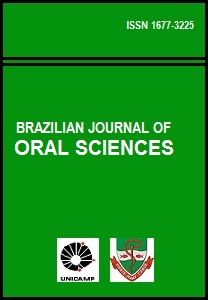Abstract
The aim of this study was to evaluate Vickers micro-hardness and flexural strength, of five commercial resin composites cured by two light curing units (LCU) with different intensities. The inorganic filling content of the composite was evaluated by thermogravimetric analysis (TGA) and the morphology of the surface was analyzed by scanning electron microscopy (SEM), in composites cured by different light intensities and immersed into a commercial soft drink or distilled water. The results show an improvement in the mechanical properties when the highest intensity of the halogen light-curing unit was used. At the same intensity of LCU, the highest values for the mechanical properties were found in specimens with a higher percentage by weight of filler. The better values were observed for micro-hardness and flexural strength in hybrid resin composites than in microfill resin composites. When the material was stored in the soft drink, changes occurred in the composite structure. The SEM images show a fractured specimen immersed in the soft drink compared with the control group, maintained in distilled water. The images show the low level of light beam penetration into resin composites, since the removal of resin components at the central part of the specimen was higher than at the surface near the light incidence.References
Rueggeberg FA, Caughman WF, Curtis JW. Effect of light intensity and exposure duration on cure of resin composite. Oper Dent. 1994; 19: 26-32.
Cook W. Spectral distributions of dental photopolymerization sources. J Dent Res. 1982; 61: 1436-8.
Martin FE. A survey of the efficiency of visible light curing units. J Dent. 1998; 26: 239-43.
Spahl W, Budzikiewicz H, Geurtzen W. Determination of leachable components from four commercial dental composites by gas and liquid chromatography/mass spectrometry. J Dent. 1998; 26: 137-45.
Friedman J. Variability of lamp characteristics in dental curing lights. J Esthet Dent. 1989; 1:189-90.
Barghi N, Berry T, Hatton C. Evaluating intensity output of curing lights in private dental offices. J Am Dent Assoc. 1994; 125: 992-6.
Miyazaki M, Hattori T, Ichiishi Y, Kondo M, Onose H, Moore BK. Evaluation of curing units used in private dental offices. Oper Dent. 1998; 23: 50-4.
Watts DC. Reaction Kinetics and mechanics in photopolymerized networks. Dent Mater. 2005; 21: 27-35.
Elliott JJE, Lovell LG, Bowman CN. Primary cyclization in the polymerization of bis-GMA and TEGDMA: a modeling approach to understanding the cure of dental resins. Dent Mater. 2001; 17: 221-9.
Leonard DL, Charlton DG, Roberts HW, Cohen ME. Polymerization Efficiency of LED Curing Lights. J Esthet Restor Dent. 2002; 14: 286-95.
New American Dental Association specification no. 27 for direct filling resins. Council on Dental Materials and Devices. J Am Dent Assoc. 1977; 94: 1191-4.
International Standards Organizations 4049. Dentistry-polymerbased filling, restorative and luting materials. Geneva, Switzerland: ISO; 2000.
Pilo R, Oelgiesser D, Cardash HS. A survey of output intensity and potential for depth of cure among light-curing units in clinical use. J Dent. 1999; 27: 235-41.
Watts DC, Amer O, Combe EC. Characteristics of visible-lightactivated composite systems. Br Dent J. 1984; 156: 209-15.
Gordan VV, Ppratel SB, Barrett AA, Shen C. Effect of Surface Finishing and Storage Media on Biaxial Flexure Strength and Microhardness of Resin-Based Composite. Oper Dent. 2003; 28: 560-7.
Yap AUJ, Mah MKS, Lye CPW, Loh PL. Influence of dietary simulating solvents on the hardness of provisional restorative materials. Dent Mater. 2004; 20: 370-6.
Adabo GL, Cruz CA, Fonseca RG, Vaz LG. The volumetric fraction of inorganic particles and the flexural strength of composites for posterior teeth. J Dent. 2003; 31: 353-9.
West NX, Hughes JA, Parker DM, Moohan M, Addy M. Development of low erosive carbonated fruit drinks 2. Evaluation of an experimental carbonated blackcurrant drink compared to a conventional carbonated drink. J Dent. 2003; 31: 361-5.
Yoon TH, Lee YK, Lim SB, Kim CW. Degree of polymerization of resin composites by different light sources. J Oral Rehabil. 2002; 29: 1165-73.
Park SH, Lee CS. The difference in degree of conversion between light-cured and additional heat-cured composites. Oper Dent. 1996; 21: 213-7.
The Brazilian Journal of Oral Sciences uses the Creative Commons license (CC), thus preserving the integrity of the articles in an open access environment.

